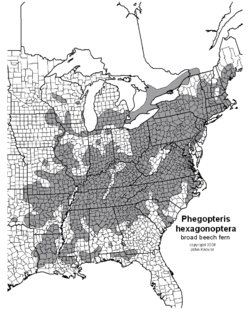| Broad beech fern | |
|---|---|
 | |
| Phegopteris hexagonoptera in spring | |
| Scientific classification | |
| Kingdom: | Plantae |
| Clade: | Tracheophytes |
| Division: | Polypodiophyta |
| Class: | Polypodiopsida |
| Order: | Polypodiales |
| Suborder: | Aspleniineae |
| Family: | Thelypteridaceae |
| Genus: | Phegopteris |
| Species: | P. hexagonoptera |
| Binomial name | |
| Phegopteris hexagonoptera | |
 | |
| Distribution | |
| Synonyms | |
Dryopteris hexagonoptera(Michx.) C. Chr. | |
Phegopteris hexagonoptera, commonly called the broad beech fern, is a common herbacious perennial forest fern native to the eastern United States and adjacent Ontario. [2] [3] [4] It grows from a creeping rootstock, sending up individual fronds that more or less clump. Its native habitat includes moist, undisturbed, hardwood forests. [5]
The fronds are broadly triangular. The specific epithet hexagonoptera, Latin for "six-sided wing", refers to the wings of leaf tissue along the rachis between the basal pinnae. [2]
Sori are small, round, and naked. [6] This aspect of the plant has caused it in the past to be placed, at first, in the genus Polypodium , then grouped with genus Dryopteris , then with the genus Thelypteris . Genetic analysis has shown the genus Phegopteris to be a sister clade to the rest of the thelypteroid ferns. [ citation needed ]
This fern makes an excellent garden plant, gradually filling in a bed. [ citation needed ]
